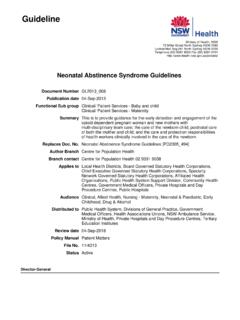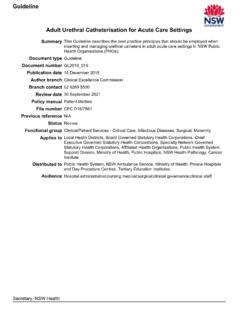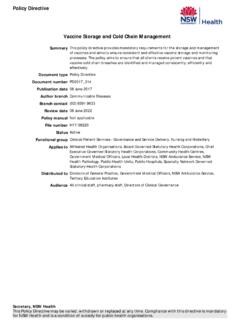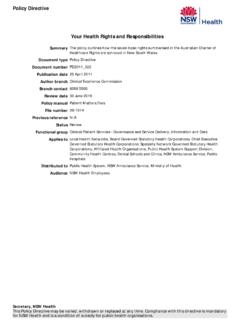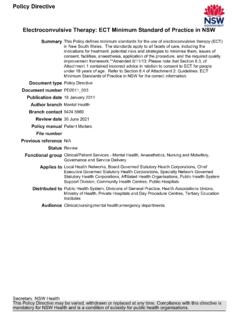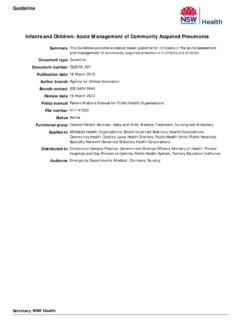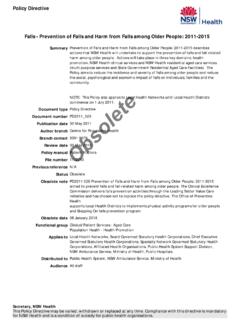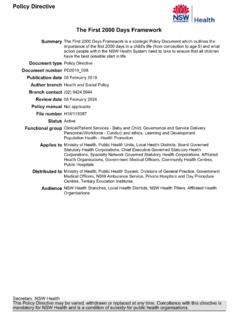Transcription of Guide to Cost-Benefit Analysis of Health Capital Projects
1 Guide to Cost-Benefit Analysis of Health Capital ProjectsSummaryThe Guide to Cost-Benefit Analysis (CBA) is an important tool in the evaluation ofproposed Health Capital Projects to determine a cost to benefit ratio of variousoptions. The Guide , which aligns to Treasury CBA guidelines, sets out theprinciples, concepts, methodology and steps to be used. CBA models and toolkitshave been developed for application to major Capital typeGuidelineDocument numberGL2018_021 Publication date02 October 2018 Author branchHealth System Planning & InvestmentBranch contact(02) 9391 9182 ReplacesGL2011_006 Review date02 October 2023 Policy manualNot applicableFile numberH18/88031 StatusActiveFunctional groupClinical/Patient Services - Governance and Service DeliveryApplies toMinistry of Health , Public Health Units, Local Health Districts, Board GovernedStatutory Health Corporations, Chief Executive Governed Statutory HealthCorporations, Specialty Network Governed Statutory Health Corporations, NSWH ealth Pathology, Public Health System Support Division, Cancer Institute, NSWA mbulance Service, Public HospitalsDistributed toMinistry of Health , Public Health System, NSW Ambulance ServiceAudienceCEs, LHDs, Capital planners, Directors of Finance, Corporate Services, AssetManagersGuidelineSecretary, NSW Health GUIDELINE SUMMARY GL2018_021 Issue date.
2 October-2018 Page 1 of 2 Guide TO Cost-Benefit Analysis OF Health Capital Projects PURPOSE The aim of this Guideline is to assist in ensuring that a robust Analysis of the cost benefits of all proposed Health Capital Projects is undertaken and presented for consideration by decision-makers. This will enable NSW Health to provide its services as efficiently and effectively as possible. The Guide sets out the principles, concepts, methodology and steps to be used in the evaluation of proposed Capital Projects . The Guide emphasises the importance of ensuring that the anticipated benefits from various Capital proposal options are clearly identified and quantified within the CBA. KEY PRINCIPLES CBA is an appraisal and evaluation technique that estimates the economic, social and environmental costs and benefits directly associated with a project or program in monetary terms. CBA offers a framework to compare the welfare of all stakeholders stemming from a project, program or investment, including direct beneficiaries, indirect beneficiaries, and users involved in program/project delivery and funding providers.
3 CBA translates the majority of outcome/impacts into a monetary value. CBA shows: Whether the benefits of a proposal are expected to exceed its costs Which option has the highest net benefit and/or benefit cost ratio (BCR) The distribution of costs and benefits across stakeholders. The results of a CBA will not be the only factor taken into account when making an investment decision, as it may be the case that benefit quantification is not possible for some services, or aspects of services. CBAs do provide important information on the effects of each possible decision. Whilst the costs of Health infrastructure investment proposals are relatively straightforward to quantify, the resulting Health benefits are much harder to value. Measurement of Health gains, Health status or well-being is difficult, as Health is a non-market good. Traditionally, economic assessment of Capital proposals has been based predominately on cost effectiveness Analysis with limited monetisation of Health benefits .
4 To-date, NSW Health has overcome these barriers by developing methodologies to monetarily quantify the value of Health benefits . This Guideline summarises key concepts, methods and approaches, including: Definition of key concepts Understanding the cause and effect of Capital investment on Health system and patient Health gain Conceptual framework for benefit identification and structuring Explanation of the differences between CBA and financial Analysis . GUIDELINE SUMMARY GL2018_021 Issue date: October-2018 Page 2 of 2 USE OF THE GUIDELINE All NSW Health Capital planners, including consultants and analysts, are encouraged to follow and apply the information, steps and processes presented in the Guide . A consistent and standardised approach to cost Benefit Analysis (CBA) facilitates comparisons across Capital proposals. CBA s are particularly important at the early planning stage, when a range of alternatives are being considered to inform the decision that a major investment is worthwhile.
5 The Guideline highlights the key times within the NSW Health Service and Capital Planning process that a CBA must be undertaken. For Capital Projects greater than $10M: Stage 1 CBA - Strategic Business Case or Investment Decision Template Stage 2 CBA - Final (Detailed) Business Case For Capital Projects less than $10M: CBA Analysis should be undertaken commensurate with the scale of the project with a summary report usually prepared. REVISION HISTORY Version Approved by Amendment notes October 2018 (GL2018_021) Deputy Secretary, Strategy and Resources Updated Guideline, replaced GL2011_006 May 2011 (GL2011_006) Director-General Updated Guideline, replaced GL2008_013 July 2008 (GL2008_013) Director-General First Guideline. ATTACHMENTS 1. NSW Health Guide to Cost-Benefit Analysis of Health Capital Projects . 2. NSW Treasury s Guide to Cost-Benefit Analysis . Guide to Cost-Benefit Analysis of Health Capital Projects August 2018 (Supplementary to NSW Treasury s Guide to Cost-Benefit Analysis ) Preface In order to ensure the best Health outcomes, it is important that NSW Health provides its services as efficiently and effectively as possible.
6 This includes ensuring that Capital investment in Health facilities is considered in the context of value for money and competing priorities. While Capital is a key enabler for the provision of Health services, NSW Health is a service agency where our people are our most important asset and patients and their families our most important customer. Consideration of how and what decisions we need to make regarding Capital investments must reflect the complexity of the Health system and the changing nature of service delivery and models of care over time. These decisions need to take into account the rapidly growing understanding that science is providing that drives step changes in both Health interventions and the use of technology. Cost-Benefit Analysis (CBA) is a way of systematically analysing all costs and benefits associated with a proposal and assessing its overall benefits .
7 Consideration of the social and economic benefits of NSW Health s Capital programs need to receive appropriate emphasis. CBA is therefore an important tool in the assessment process. The analytical technique when applied in accordance with best practice provides a rational and logical structure to assist in making decisions about Capital Projects , program initiatives and policy proposals. Since 2010, NSW Health has progressively developed methods and approaches to value Health benefits in monetary terms in order to calculate the net economic benefit of a Capital project or program. NSW Health acknowledges NSW Treasury s ongoing advice and support in this journey. This Guide to CBA of Health Capital Projects updates and supersedes the 2011 version of NSW Health Economic Appraisal Guidelines. The purpose is to supplement NSW Treasury s policy and guidelines paper, with particular focus for Health Capital project proposals.
8 The Guide sets out the principles, concepts, methodology and steps to be used in the evaluation of proposed Capital Projects . CBA models and toolkits have been developed by Health Infrastructure for application to major Capital proposals. CBA has become more mainstream in Capital project evaluation. NSW Health has shared our experience and benefit valuation methods with other jurisdictions, following their expression of interests in applying NSW Health s benefit assessment methods to their Capital Projects . NSW Health will continue to foster continual improvement in the preparation of CBAs, which will include relevant research evidence on quantification and valuation of Health benefits . Worldwide, healthcare is changing to keep pace with the needs and expectations of patients, carers, clinicians and communities. Like many other Health systems, NSW Health is moving from volume-based care towards value-based, patient-centred care.
9 Value based healthcare also extends into how we use our current built assets, as well as how we make decisions about how much and where we invest Capital in the future to maximise the outcomes we are seeking to achieve. Value in the value based healthcare includes improvements in outcomes (patient reported measures), improvements in the experiences of receiving care (patient and carer), experience of providing care (clinician) and effectiveness (clinical outcomes, quality and utilisation of resources). This value definition is broader than the value of Health gains used in the Capital Projects CBA. Dr Nigel Lyons Deputy Secretary, Strategy and Resources Ministry of Health August 2018 Contents PREFACE .. I 1. INTRODUCTION .. 1 PURPOSE OF THIS DOCUMENT .. 1 CBA OF Capital Projects .. 1 WHEN AND HOW SHOULD THE CBA BE UNDERTAKEN? .. 2 STRUCTURE OF THIS Guide .. 2 2.
10 cost BENEFIT Analysis AND THE PLANNING PROCESS .. 4 OVERVIEW OF Capital PROPOSALS IN THE OVERALL PLANNING PROCESS .. 4 INVESTMENT DECISION TEMPLATE .. 5 STRATEGIC BUSINESS CASE .. 5 FINAL BUSINESS CASE .. 6 ROLES, RESPONSIBILITIES AND RESOURCING FOR CBA .. 7 3. OVERVIEW OF CBA PRINCIPLES, CONCEPTS AND APPROACH .. 8 INTRODUCTION .. 8 KEY CONCEPTS .. 8 INVESTMENT DRIVERS: CAUSE AND EFFECT .. 9 CONCEPTUAL FRAMEWORK FOR BENEFIT IDENTIFICATION AND STRUCTURING .. 10 RANGE OF Health , SOCIAL AND COMMUNITY benefits .. 11 DIFFERENCES BETWEEN A CBA AND cost EFFECTIVENESS Analysis .. 12 DIFFERENCES BETWEEN A CBA AND FINANCIAL 13 4. STEPS IN Cost-Benefit Analysis .. 14 INTRODUCTION .. 14 STATING THE OBJECTIVES .. 15 DEFINE THE BASE CASE AND DEVELOP OPTIONS .. 16 IDENTIFY AND FORECAST COSTS AND benefits .. 21 VALUE THE COSTS AND benefits .. 22 IDENTIFY QUALITATIVE FACTORS AND DISTRIBUTION IMPACTS.
